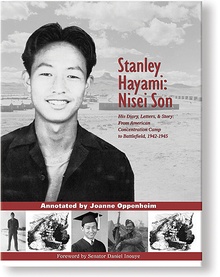Author Joanne Oppenheim never met Stanley Hayami, but after reading the young man’s wartime diary, she has never forgotten him.
In many respects, the 16-year-old Hayami was a typical American teenager, beginning a diary about his struggles to get good grades in school and to decide what he wanted to be when he grew up. His aspirations for the future echoed that of so many young people who were coming of age in America in the 1940s.
But in Hayami’s case there was one critical difference. He was writing from inside a concentration camp, where he and his family were incarcerated against their will. A couple of years later, he was drafted into the legendary U.S. Army 442nd Infantry Regimental Combat Team and continued to write, via letters to his family. He was ultimately killed in battle, at the age of 19, while trying to rescue a fellow soldier.
“I began work on the Stanley Hayami, Nisei Son project three years ago,” says Oppenheim. “It was part of a bigger book that I had planned to do about the Heart Mountain camp. But Stan’s story kept insisting on taking over.”
Hayami’s diary, which included drawings and sketches, evoked themes that Oppenheim found emotionally compelling—and eerily familiar.
“Although I was only seven when the war began, I was pretty sure that the blackout curtains my mother put on the windows were proof positive that bombs would fall at any time (in America)—and that if the Germans were to get here, that children like me might be taken away or worse,” Oppenheim recalls. “I always thought I was an American girl and suddenly I had another identity—I was Jewish and that could be really dangerous.”
“We did not know the details of the German death camps in 1941, but we were not unaware that terrible things were happening to the Jews in Europe,” Oppenheim says. “I remember my father listening to the shortwave broadcasts of the last days of the Warsaw Ghetto and his weeping as he told us that his family in Poland was gone now. It was my first understanding that being Jewish might make me different, that some people hated other people just because they happened to be born of a certain religion or ethnic group.”
“As I began to do the research for my previous book, Dear Miss Breed, and Stanley Hayami’s story, many of those childhood feelings resurfaced,” says Oppenheim. “As the daughter of an immigrant, I felt a connection to Stanley and other Nisei. I was also shocked that none of this history had been taught in my years of schooling. So much Asian American history has been ignored,” Oppenheim notes.
With the help of Hayami’s relatives and others—including U.S. Senator Daniel K. Inouye, who served as Hayami’s platoon leader and wrote the foreward to the book—Oppenheim uncovered some of that hidden history.
“Stan’s family not only found the letters he wrote from the service, but also put me in touch with others who knew Stan,” says Oppenheim. “Walter Hayami, his kid brother, was still alive and able to tell me stories about Stan that only a brother would know. I was also lucky enough to find a long letter that his older brother Frank Hayami had written to Mike Mackey, a historian in Wyoming. So the book includes the voices of the three brothers and that made a huge difference in conveying Stan’s life and his experiences.”
Oppenheim believes that those experiences, while from a time more than six decades in the past, have great value today. The California Civil Liberties Public Education Program (CCLPEP) agreed, and provided support for the project.
“I was particularly struck when I read Stan’s writings about his dreams for a ‘United Nations of Earth,’” says Oppenheim. “Of course, he knew about the failed League of Nations and acknowledges that he is not the first to dream of such a world. Still, for a teen-aged boy he had big ideas about how education, a shared language, and communication would be key to creating a world that could live in peace.”
“My hope is that present-day teens will be inspired by Stan’s optimism, in spite of all the obstacles that were put in his way,” says Oppenheim. “So often young people feel that they are the only ones who are dished up tough times, and because they have limited experience, they often cannot see the end of it. The tragedy of Stan’s life was that he never got to live his dreams...but it was not from lack of trying. I think Stan’s idealism and hopes for a future, offer a different model. He never gave up on his aspirations and working to make himself ready for that future. So many Nisei sons and daughters did not accept the limitations that generally prescribed a narrow path in the prewar world. Their children and grandchildren have had a richer and better life thanks to their sacrifices.”
“One has a sense that Stan could have become whatever he wanted to be...he had such talents,” Oppenheim remarks. “That is the tragedy of Stan’s young life and the war that cost the lives of so many young people who can never be replaced. Perhaps the best way to honor their sacrifice is to make the most of the opportunities and talents we are given. To work in our own ways to make this a ‘United Nations of Earth’ that Stanley dreamed about so long ago.”
Stanley Hayami’s diary is part of the Japanese American National Museum’s permanent collection.
* This article was originally published on the Japanese American National Museum Store Online on November 2008.
© 2008 Japanese American National Museum







